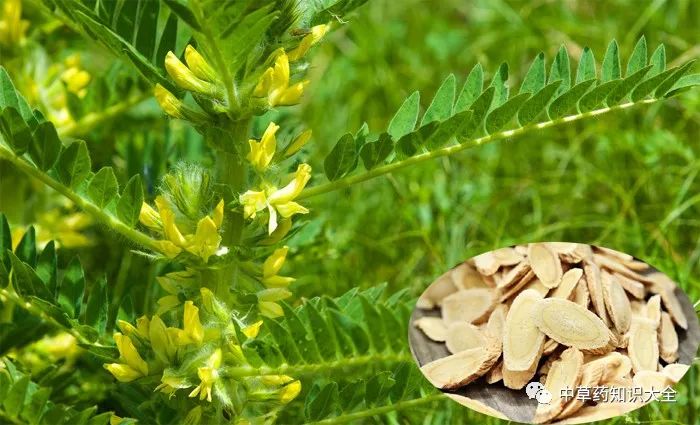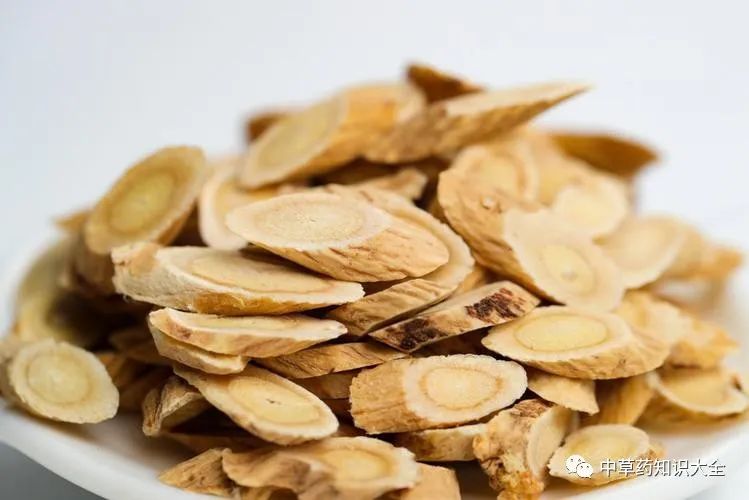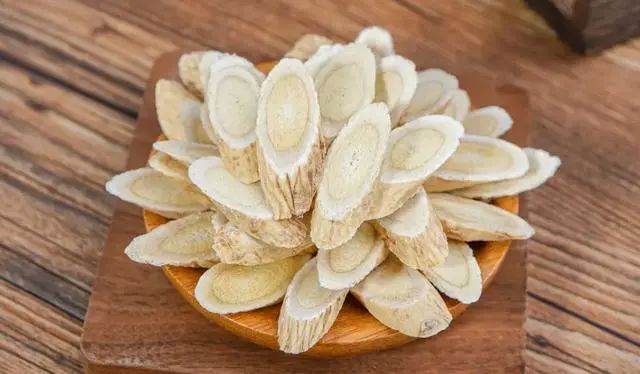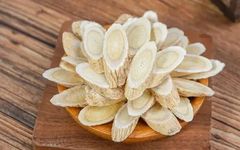Pinyin Huánɡ Qí

Alias Mian Huang Qi
English Name Radix Astragali
Source The root of the leguminous plant Mongolian Huang Qi (Astragalus membranaceus Bge. var. mongholicus (Bge.) Hsiao). Harvested in spring and autumn, the soil, fibrous roots, and root tips are removed, then dried until 60-70% dry, bundled straight, and then fully dried.

Habitat Distribution Grows in sunny grasslands and hillsides. Mainly produced in Inner Mongolia, Shanxi, and Heilongjiang; now widely cultivated.
 Morphology A perennial herb. The stem is erect, with branches in the upper part. The odd-pinnate compound leaves are alternate, with 12-18 pairs of leaflets; the leaflets are broadly oval or oval-shaped, covered with soft hairs underneath; stipules are lanceolate. The racemose inflorescence is axillary; the calyx is bell-shaped, densely covered with short soft hairs, with 5 calyx teeth; the corolla is yellow, with the standard petal being long oval-shaped, and the wings and keel petals both have long claws; there are 10 stamens, in two groups; the ovary has a long stalk. The pod is membranous, semi-oval, and hairless. Flowering period is June to July, fruiting period is July to September.
Morphology A perennial herb. The stem is erect, with branches in the upper part. The odd-pinnate compound leaves are alternate, with 12-18 pairs of leaflets; the leaflets are broadly oval or oval-shaped, covered with soft hairs underneath; stipules are lanceolate. The racemose inflorescence is axillary; the calyx is bell-shaped, densely covered with short soft hairs, with 5 calyx teeth; the corolla is yellow, with the standard petal being long oval-shaped, and the wings and keel petals both have long claws; there are 10 stamens, in two groups; the ovary has a long stalk. The pod is membranous, semi-oval, and hairless. Flowering period is June to July, fruiting period is July to September.
 Characteristics The root is cylindrical, sometimes branched, thicker at the top, slightly twisted, 30-90 cm long, and 0.7-3.5 cm in diameter. The surface is light brown to light brownish-yellow, with irregular longitudinal wrinkles and horizontal lenticels; the cork easily peels off, revealing the yellow-white cortex, and some may show a reticulate fiber bundle. The texture is tough, with a strong fibrous fracture. The aroma is faint, the taste is slightly sweet, with a bean-like odor.
Characteristics The root is cylindrical, sometimes branched, thicker at the top, slightly twisted, 30-90 cm long, and 0.7-3.5 cm in diameter. The surface is light brown to light brownish-yellow, with irregular longitudinal wrinkles and horizontal lenticels; the cork easily peels off, revealing the yellow-white cortex, and some may show a reticulate fiber bundle. The texture is tough, with a strong fibrous fracture. The aroma is faint, the taste is slightly sweet, with a bean-like odor.
Chemical Components Contains flavonoids such as calycosin, 3-hydroxy-9,10-dimethoxy-β-carboline, and also contains astragalosides I, V, and III.
Properties and Taste Warm in nature, sweet in taste.
Functions and Indications Tonifies Qi and stabilizes the exterior, clears toxins and promotes pus discharge, diuretic, promotes tissue regeneration. Used for Qi deficiency, fatigue, chronic diarrhea, prolapse of the rectum, spontaneous sweating, edema, uterine prolapse, chronic nephritis with proteinuria, diabetes, and non-healing sores.
Formulas 1. For urinary obstruction. Use 2 qian of Huang Qi, add 2 bowls of water, decoct to 1 bowl, take warm. For children, reduce by half.
2. For alcoholic jaundice (feeling cold after drinking, with red, black, and yellow spots on the body). Use 2 liang of Huang Qi and 1 liang of Magnolia, grind finely. Take a small amount each time. Take three times a day, with wine.
3. For leukorrhea. Use 0.5 liang of salt-fried Huang Qi and 1 liang of Poria, grind finely. Take 1 qian each time.
4. For atrophy and thirst (accompanied by abscesses). Use 6 liang of Huang Qi, half raw and half steamed with salt water; also use 1 liang of licorice, half raw and half charred. Grind both medicines finely. Take 2 qian, twice a day. Can also be decocted. This formula is called “Huang Qi Liu Yi Decoction.”
5. For constipation in the elderly. Use 0.5 liang each of Huang Qi and Chen Pi, grind finely. Also use 1 handful of hemp seeds, crush, add water to extract the juice, decoct until half dry, mix in 1 spoon of honey, then add the powdered Huang Qi and Chen Pi and mix well. Two doses can relieve constipation. Can be taken regularly.
6. For blood lin (hematuria). Use equal parts of Huang Qi and Huang Lian, grind into powder, make into pills the size of mung beans. Take 30 pills each time.
7. For less lin (dysuria). Use equal parts of Huang Qi and Ren Shen, grind into powder. Also use 4-5 slices of radish, add 2 liang of honey, slightly charred, dip in the powdered medicine and take with salt water.
8. For hemoptysis. Use 2.5 qian of Huang Qi and 5 qian of purple-back duckweed, grind into powder. Take 1 qian, with ginger honey water.
9. For coughing up pus and blood, dry throat (this is due to deficiency heat, do not take cold medicine). Use 4 liang of Huang Qi and 1 liang of licorice, grind into powder. Take 2 qian, with hot water.
10. For lung abscess. Use 2 liang of Huang Qi, grind finely, take 2 qian decocted. Can take 3-4 times a day.
11. For paronychia (red flesh protruding at the edge of the toenail). Use 2 liang of Huang Qi and 1 liang of mushroom, soak in vinegar overnight, add 5 he of lard, simmer on low heat until 2 he. Strain, take the fat and apply to the sore. Three times a day.
12. For fetal movement discomfort (abdominal pain, yellow discharge). Use 1 liang each of Huang Qi and Chuan Xiong, 1 handful of glutinous rice, 1 liter of water, cook until half done. Take in portions.
13. For damp itching. Use Huang Qi stir-fried in wine, grind finely, and eat with cooked pig heart, effective.
Excerpt from “Dictionary of Chinese Medicinal Herbs”
Note:This account aims to promote traditional Chinese medicine culture. The TCM knowledge mentioned in the text is for learning and exchange purposes only.
WeChat has been updated! If youneither★starred me, nor liked or

